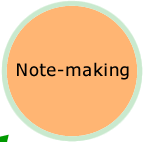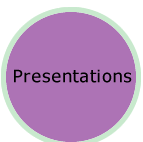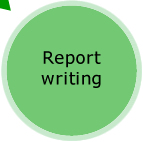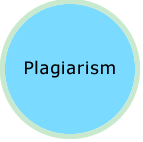 |
|||
- Reading
- Note-making
- Essay writing
- Report writing
- Plagiarism
- Critical Thinking & Analysis
- Presentations
- Examinations
Preview of Course
Here you can Preview selected areas from the course. Use the navigational diagram below to access the section you want to view by just clicking on the appropriate circle. Or you can just scroll down the page to view the preview sections in order. At the end of each section, there is a series of questions to test the student's understanding of the module.
The Preview contains selected texts to give a flavour of content. They may, therefore, appear to be out of context - please remember that they are just EXAMPLES.
|
|||||||||||||||||||||||||||||||||||||||||||||||||||||||||||||||||||||||||||||||||||||
| Back to top of page ^ |
Reading techniques
Can one improve the ways one reads, or is reading ‘just’ reading, with nothing more to be said about it?
TEST THESE IDEAS AND TECHNIQUES AND SEE IF THEY MAKE A DIFFERENCE:
Can you think of reasons why an overview of any subject you may be studying could make reading easier?
Think of the following situation:
When builders start building a house, where do they start? Do they start on one wall and build that up brick by brick before going on to the next wall? Or do they lay the foundations for the whole house first and gradually work towards building the single rooms and laying the bricks for those? I think you’ll find that builders first lay the whole foundation and work from this to smaller and smaller divisions of the building.
Now jot down any similarities between laying a foundation for a house and developing reading techniques for a book or the chapter of a book.
Many study skills authors are in favour of getting ‘the big picture’ first before studying a subject in detail. Various explanations have been suggested for why we sometimes remember things we read and why we sometimes don’t remember them afterwards. One that I find convincing is for us to imagine that we have something like hooks attached to our brain cells. When we read something we already know something about (that is when we already have a hook to attach this new information to) we understand and remember it better.
If we don’t know anything about a subject it can be difficult, as we know, to understand and remember what we have read about it. So it is a good idea to try to develop those hooks.
How can we do this?
One way is to get an overview of the subject, as this will give us the main topics or foundations of the subject.
How do we get an overview?
Exercise 3:
This exercise continues... etc.
| Note-making |
| Back to top of page ^ |
Linear notes
Linear notes have the advantage
- if one is making notes in a hurry, without having the time and space to control the flow of information
- true of lectures, especially if the lecturer does not have a clear structure to his or her lecture or the information is complex
- also true of films or videos shown to you, where you would be unlikely to be able to slow things down or repeat them
If you have to choose between linear notes as sentences or in note form, which do you think would be more effective?
Using the same text, try making both linear and diagrammatic notes and see which you think works better:
The disadvantages of linear notes are that you cannot use them as flexibly as diagrammatic notes
The advantages of mind maps are that the ideas can easily be divided up and clearly seen. It encourages independent, active learning as you decide how to make the divisions. The information and connections are there on the page – they are completely clear and visible at just one glance. It also gives you freedom to organise the material as you think is useful, rather than writing down one point after another from the way it is ordered in the book or article you are reading. Mind maps also allow you easily to order information into different categories – as with headings and subheadings. This can also be done with linear bullet points, but the advantage of mind maps here is that you can often add on points later. It is also fun to do – you can do drawings along with ideas and use different colour pens. You can also easily draw connections between different ideas. Look at the way I have ordered the main points and also made connections between them in the above mind map.
Diagrammatic notes – mind maps
Look at the mind map below setting out the advantages of mind maps.

This exercise continues... etc.
| Essay writing |
| Back to top of page ^ |
Now jot down what positive experiences you have had writing essays:
- What made them positive?
- What negative experiences have you had writing essays?
- What made them negative?
- Can you think of ways of making your experience of essay writing even more positive?
- Below are some ideas which we hope will be useful in making essay writing more positive, more effective and more enjoyable:
A. Planning and structuring your essay
 Diagram 3 Aspects of essay writing
Diagram 3 Aspects of essay writing
- Work out what the set question means and what it requires
- Work from your own ideas first
- Spend time working out everything you need to know and everything you need to find out to answer the essay question
- Develop your own ideas and your own essay plan or structure for the essay before looking at other sources such as your lecture notes, books and journal articles.
What are the advantages in doing this?
- you will be less tempted to use others’ ideas and structures uncritically if you have thought about the essay yourself first, and written down ideas and an essay plan
- rather, you would be using others’ ideas to support your own analysis rather than mindlessly copying from them
- you are therefore less likely to plagiarise others’ work
- it will be easier for you to use information and ideas you read about in your own framework rather than in others’ frameworks
- your work is likely to be more interesting and relevant to the question asked if you use your own ideas and essay structure as a basis
- you are likely to enjoy this kind of research and writing more as you are using your own mind and intelligence to make your own choices about what material to include and where to use it in your structure
- using your own ideas and structure (even if they need to be modified later) gives you the opportunity to be an independent learner
Exercise 1
This exercise continues... etc.
| Report writing |
| Back to top of page ^ |
Exercise 1:
Below is an example of a set of terms of references that you might have to write a report on:
“Calculate the increase in the number of international students in English universities between 2003 and 2010. Give some reasons for this increase.”
Boundaries of the terms of reference:
What have you been asked to investigate / analyse?
Write your answer on your computer, smart phone or in your notebook:
You have been asked to do 2 things:
i) to calculate how many international students were recruited in English universities between 2003 and 2010
ii) to give reasons for the increase in the numbers
What issues / aspects must you include?
You must include all international students whether they are undergraduate or postgraduate students who have studied at English universities between 2003 and 2010.
This exercise continues... etc.
| Plagiarism |
| Back to top of page ^ |
3. If we repeat someone else’s work but use our own words, does this constitute plagiarism?
This again is not clear cut, for as with question 2, it depends on how much you are going to do this.
What is not acceptable is if you take someone else’s text wholly or largely and simply repeat it using your own words.
Again this means that you lose the opportunity of working out your own arguments, your own essay structure and doing your own research.
It also means you do not effectively do your own writing.
So again, it is fine to use someone else’s ideas AS PART OF YOUR OWN ARGUMENT, STRUCTURE AND WRITING.
It is not okay to paraphrase large sections of someone else’s work, as it is then not your own work.
You are then passing off someone else’s work as your own, even if you have used different words – and that is the definition of plagiarism!
4. What are the consequences if you are found to have plagiarised?
This depends on the policies of your school, college or university.
The consequences can be serious.
Sometimes you may simply fail the unit or module in question.
A more serious penalty would be to suspend you for a semester or a year from the institution.
Most serious would be if you were expelled.
Another very serious consequence could be a note on your record that you were found guilty of plagiarism.
This note could be there for a certain time or in the worst case it could be there as a permanent record on your file.
Given these consequences it is best never to plagiarise!
This exercise continues... etc.
| Critical Thinking & Analysis |
| Back to top of page ^ |
What is Critical Thinking?
Much of what has been written above about knowledge is also relevant to critical thinking.
It is NOT about being critical in a negative sense, for its own sake, though it is all right to disagree with some of what you read.
There are different levels of critical thinking and, following on from critical thinking, critical analysis:
Basic level:
- checking that what you are reading is valid (this will also apply to your own writing)
- how can you judge this?
You must ensure that:
- the knowledge must be solid and credible
- statements must be supported by facts, ideas, theories based on research
- statements and analysis must be fully referenced to show sources of information
- there must be no unsupported statements or ideas
- How can you check the quality of the analysis?
- the analysis should be consistent throughout
- all statements must fit in with each other
- there should be no contradictions between one part of the analysis and another
- of course the analysis could show different viewpoints but the overall argument must follow one line of thinking and logic
- there should be a logical structure to the writing
- each statement should follow on from the one before
- each paragraph should also follow from the one before and lead into the next one
- the analysis should be consistent throughout
Deeper levels:
- this is linked in with what has been written above about different types of knowledge
- what you read is to an extent not neutral, not objective and not unbiased (though very biased, emotive writing with no scholarly support must be avoided)
- it is working out what kind of knowledge you are reading when it is scholarly, supported by evidence and theory
Exercise 3
This is another exercise comparing two different writers on the same subject:
This exercise continues... etc.
| Presentations |
| Back to top of page ^ |
Audience:
- Be clear as to who your audience is likely to be
This could affect:
- the subject matter you choose
- the way you present it
- the degree of depth and breadth of your subject matter
- the kind of language you use
For example:
- for an academic presentation you will probably be expected to include in-depth analysis supported by theory
- for a job interview you will probably have to concentrate more on your personal skills and experience as well as on your knowledge of the organisation and perhaps the knowledge of the whole sector
Subject matter:
- ensure you know your subject thoroughly
- but this does not mean you have to know everything about the subject
- as with essay preparation, set yourself boundaries as to what material you will include, and what material you will exclude
Academic subject matter: How will you ensure that you know your subject thoroughly?
For an academic presentation these suggestions are similar to those for preparing for an essay:
- work out everything you know about the subject and questions you want to ask
- choose your reading carefully
- read critically (see section on Critical Thinking and Analysis)
- make sure you have a clear, logical structure (see section on Essay Writing)
- make independent notes easy to access
Is this enough and, if not, what more is needed?
You need to summarise these notes for...
This exercise continues... etc.
| Examinations |
| Back to top of page ^ |
How to revise
Principles to follow - you must be:
- an active, independent reviser
- in control of the material
- finally getting an overall picture of the subject
- enjoying yourself
How to achieve these principles?
Making revision notes is a way to:
- keep you active
- encourage you to make choices
- help you absorb the subject matter
What kind of notes will you make?
See Note-making section:
- you need to make the type of notes that will help you revise:
- they should be easy to find
- they should be easy to read
- they should be able to be easily sorted according to topic
After making sets of notes - what then?
You need to arrange the notes so that together they make sense for each topic:
- ‘play’ with the notes
- arrange them in different ways according to the topic and also according to different questions you might get on the same topic
- even if you don’t know what topics or questions are coming up, it is worth guessing what they might be and preparing answers for them. That way you will be better able to answer whatever topic and question does come up.
This exercise continues... etc.
























